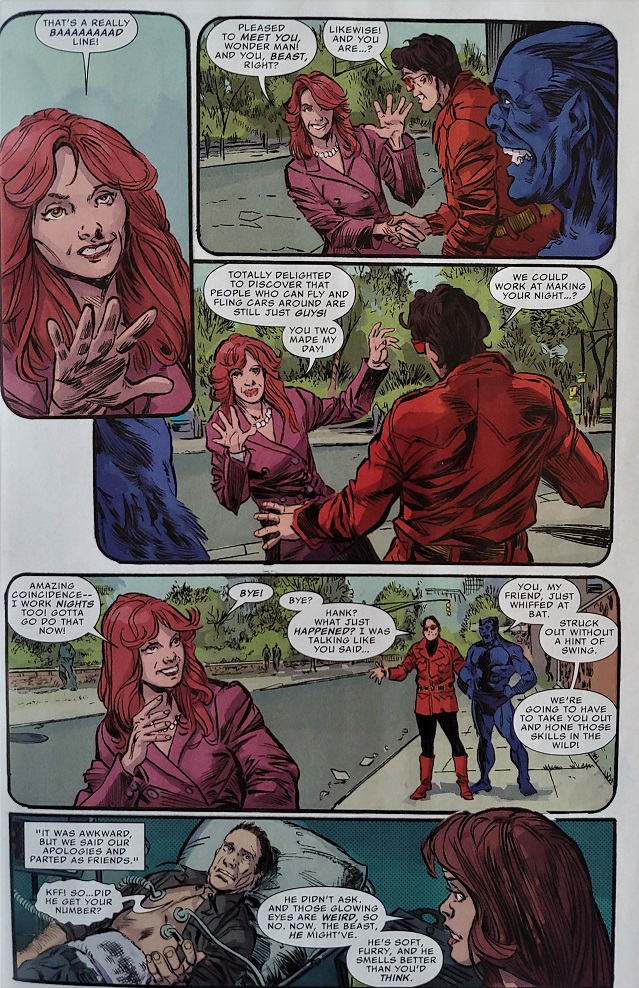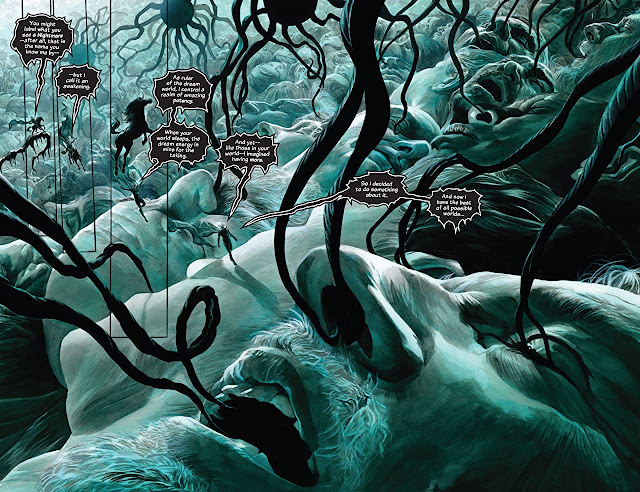Every year I spend hours making a ranking of the best published titles and the best authors. 2020 was a strange year, the first time in a decade in which no British writers were on my best-of list. It was also the first time I included a writer on the list based on a single comic book. That writer is Barbara Randall Kesel and the comic is “Heart Rate” (originally published in Avengers: Marvels Snapshots, January 2021).
 |
| Alex Ross |
The story is told from the perspective of Kerry, a woman who has recently moved to New York and is virtually homeless due to a supervillain destroying the building in which she lived. Relying on favors and asking friends for help, she is slowly starting to rebuild her life. Until one day, of course, a gigantic robot starts to destroy the neighborhood and the Avengers can’t stop it on time.
 |
| Kerry & Jay |
Kerry has to find shelter as soon as possible, and in the chaos she runs into police officer Jay, who’s trying to help people. Together they try to calm down everyone by asking them to tell stories of their lives in New York, the city with the largest amount per capita of superheroes. Kerry remembers how she casually met Wonder Man and Beast outside the Avengers mansion, and how unimpressed she was with Wonder Man’s flirtation. All of this is connected to Michelinie and Byrne's run on Avengers. Jay’s story takes place in a bar, in which Tony Stark is drinking (the story, of course, takes place during the Demon in a Bottle saga, when Iron Man becomes an alcoholic). Jay has a heated debate with Tony, whom he has never met before. However, as irritated as Tony might be, he recognizes that Jay was right, and a couple of minutes later, as Iron Man, he makes him an offer.
 |
| Thor, Count Nefaria, Iron Man & Captain America |
While the battle rages on, the normal men and women of New York are surviving and doing what humanity always does in its darkest hours: telling stories. Kerry and Jay are remembering what it means to live among people with extraordinary powers and abilities. In a desperate situation and against all odds, Kerry and Jay find each other and promise to become a couple if they survive the day. Barbara Randall Kesel does a remarkable job that doesn’t focus on the love between a man and a woman but rather on the promise of that future love. And perhaps for anyone that has recently broken up with their significant other, that promise seems to be of the utmost importance. Staz Johnson pencils these pages with grace and aplomb, while veteran inker Tom Palmer pitches in, and Jim Charalampidis colors it. Alex Ross’ depiction of the armored avenger is as stunning as it is heroic.
 |
| Wonder Man, Beast & Kerry |
In Captain America: Marvels Snapshots (June 2020), writer Mark Russell asks what is the result of racial segregation in the Marvel Universe. In an impoverished black community, the effects of a large-scale attack are more devastating than ever. However, even a superhero like Captain America doesn’t realize what is going on and considers matters solved as soon as the threat has been dealt with. Felix, an African American boy, had already proved to be smarter than everyone else, but his family has no money, no resources, and after the attack, the situation is even worse. Felix is an intelligent boy, but desperate as he is, he ends up joining the ranks of the criminal organization A.I.M. I applaud Russell for trying to answer questions about race, poverty and unequal access to opportunities. The dynamic art is provided by Ramón Pérez and the coloring by Rico Renzi. In his cover, Alex Ross paints a Captain America that not only has a noble expression but also a posture that screams determination, as it is befitting to the Sentinel of Liberty.
________________________________________________________________________________________________________
________________________________________________________________________________________________________
Todos los años me paso horas haciendo un ranking de los mejores títulos publicados y de los mejores autores. El 2020 fue un año extraño, la primera vez en una década en la que ningún escritor británico estaba en mi lista de los mejores. También fue la primera vez que incluí a una escritora en la lista basándome en un sólo cómic. Esa escritora es Barbara Randall Kesel y el cómic es "El pulso del corazón" (publicado originalmente en Avengers: Marvels Snapshots, enero de 2021).
 |
| Alex Ross |
La historia se cuenta desde la perspectiva de Kerry, una mujer que se ha mudado recientemente a New York y está prácticamente sin techo debido a que un supervillano destruyó el edificio en el que vivía. Apoyándose en favores y pidiendo ayuda a sus amigos, poco a poco ella está comenzando a reconstruir su vida. Hasta que un día, por supuesto, un robot gigantesco comienza a destruir el vecindario y los Vengadores no pueden detenerlo a tiempo.
 |
| Captain America & Falcon |
Kerry tiene que encontrar refugio lo antes posible, y en el caos se encuentra con el oficial de policía Jay, que está tratando de ayudar a la gente. Juntos intentan calmar a todos pidiéndoles que cuenten historias de sus vidas en New York, la ciudad con mayor cantidad per cápita de superhéroes. Kerry recuerda cómo conoció casualmente a Wonder Man y Beast afuera de la mansión de los Vengadores, y lo poco impresionada que estuvo con el flirteo de Wonder Man. Todo esto está conectado a la etapa de Avengers de Michelinie y Byrne. La historia de Jay ocurre en un bar, en el que Tony Stark está bebiendo (la historia, por supuesto, tiene lugar durante la saga El demonio en la botella, cuando Iron Man se vuelve alcohólico). Jay tiene un acalorado debate con Tony, a quien nunca antes había conocido. Sin embargo, por muy irritado que esté Tony, reconoce que Jay tenía razón, y un par de minutos después, como Iron Man, le hace una oferta.
 |
| New York |
Mientras la batalla continúa, los hombres y mujeres normales de New York sobreviven y hacen lo que la humanidad siempre hace en sus horas más oscuras: contar historias. Kerry y Jay están recordando lo que significa vivir entre personas con habilidades y poderes extraordinarios. En una situación desesperada y contra todo pronóstico, Kerry y Jay se encuentran y prometen convertirse en pareja si sobreviven el día. Barbara Randall Kesel hace un trabajo extraordinario que no se centra en el amor entre un hombre y una mujer, sino en la promesa de ese amor futuro. Y quizás para cualquiera que haya roto recientemente con su pareja, esa promesa parece ser de suma importancia. Staz Johnson dibuja estas páginas con gracia y aplomo, mientras que el entintador veterano Tom Palmer colabora y Jim Charalampidis colorea. La representación de Alex Ross del vengador acorazado es tan impresionante como heroica.
 |
| Felix |
En Captain America: Marvels Snapshots (junio de 2020), el escritor Mark Russell pregunta cuál es el resultado de la segregación racial en el Universo Marvel. En una comunidad negra empobrecida, los efectos de un ataque a gran escala son más devastadores que nunca. Sin embargo, incluso un superhéroe como el Capitán América no se da cuenta de lo que está sucediendo y considera que los asuntos se resuelven tan pronto como se arresta a los villanos. Félix, un niño afroamericano, ya había demostrado ser más inteligente que los demás, pero su familia no tiene dinero ni recursos, y después del ataque, la situación es aún peor. Félix es un chico inteligente, pero desesperado como está, acaba uniéndose a las filas de la organización criminal A.I.M. Aplaudo a Russell por intentar responder preguntas sobre raza, pobreza y acceso desigual a las oportunidades. El arte dinámico lo aporta Ramón Pérez y el color es de Rico Renzi. En su portada, Alex Ross pinta a un Capitán América que no sólo tiene una expresión noble sino también una postura que grita determinación, como corresponde al Centinela de la Libertad.













